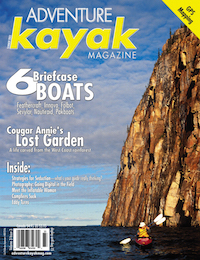As a Lake Superior sea kayak guide, I have become accustomed to a watery horizon and shorelines of granite, cobble, sand and cedar. On the St. Mary’s River, however, concrete, steel and glass replace the natural rock and forest; smoke-belching industry and the blanket of society have wiped out any feeling of wilderness. But I have learned that wilderness lies in the eyes and mind of the beholder. The St. Mary’s River is my teacher, aided by the ghosts of an enchanted past.
Road-weary visitors to Sault Ste. Marie, Ontario, can enjoy a full-day, half-day or evening tour on the St. Mary’s. The view from the water affords a new perspective of this city of 75,000, and for paddlers on their way to the splendours of Lake Superior, a stop here is a good way to loosen up and get a sense of the area’s history.
With the international border running down its spine, the St. Mary’s is bounded by Sault Ste. Marie, Ontario, to the north, and the smaller Sault Ste. Marie, Michigan, to the south. The river—the only connecting channel between lakes Superior and Huron—begins in dramatic fashion, dropping six metres out of Superior in a kilometre-long rapid, before flowing placidly for another 80 kilometres.
Sea kayakers can explore either side of the bor- der—from the two-kilometre-wide main channel below the rapids to the narrow, island-pocked pas- sages on the American side—but you must obey bor- der laws and land on the same side you launch from. For a two-hour paddle, I launch my kayak at the Pine Street Marina on the Canadian side and follow the main channel upstream. There are also good access points with plenty of parking at the Bellevue Park Marina, just east of Pine Street, or the small sandy beach by the downtown public library. On the U.S. side, launch from the Sugar Island ferry docks in the east end of Sault, Michigan, or from Sherman Park, upstream from the locks.
Heading upriver toward the International Bridge, I ignore the sights and sounds and slip back in time. The motorboats buzzing around me become the canoes of the natives; the massive lake freighters, Montreal canoes bound for Lachine or Fort William.
The glimmering reflections from the windows of riverside estates reappear as campfires, and the hum of traffic fills my ears as the singing of voyageurs. The tugs and barges moored at the Purvis Marine Pier morph into the glacial boulders strewn beneath the cliffs of Old Woman Bay, Lake Superior, and swallows swoop down from barge cavities like peregrine falcons from the cliffs.
The setting sun is framed by the International Bridge and reflects from the amber-tinted windows of city hall. Beyond Purvis Pier, three kilometres from my launching point, I begin my 20-minute ferry glide against a moderate current to Whitefish Island and the base of the St. Mary’s rapids.
Like the Ojibwa, I too am drawn to Bawating—the “place of falling waters” that marks Lake Superior’s eastern terminus. Before hydro development, the Falls of the St. Mary’s were several kilometres long and spanned the entire one-kilometre width of the river. Centrally located and with an abundance of whitefish, Bawating provided a summer rendezvous site for some 10,000 nomadic Ojibwa. Whitefish Island, a large island on the Canadian side of the rapids, contains archaeological evidence of 4,000 years of seasonal use. Yet in only 200 years of European inhabitation, the fishery was decimated. The wild attributes of the St. Mary’s River, maimed by development, have been lost forever.
The St. Mary’s was recently designated a Canadian Heritage River and is also con- tained within the managed boundaries of the Great Lakes Heritage Coast—which stretches from the Ontario–Minnesota border on Lake Superior to Georgian Bay’s Port Severn. No such designation can restore the river to its former splendour, but in the magic hour of the early morning mist or the evening’s set- ting sun, there are moments when the past overpowers the present. Tonight, it’s as though nothing has gone wrong. I see the fires and hear the drums and songs of reunit- ing people. I sit and reflect amidst the roar of the ever-powerful rapids before paddling on toward another era in the history of the St. Mary’s.
It was the construction of locks, a 15-minute paddle north of the rapids, which tamed the wilderness of the St. Mary’s. No longer was it necessary to endure the long portage upstream; gone was the danger of damaging a birchbark canoe on the downstream run.
Today, the American locks continue to provide commercial access to the breadbasket of the continent. The Canadian locks—a National Historic Site—allow for small craft thoroughfare.
I often lock through, following the posted protocol to call the lockmaster on my marine radio, then posing for the cameras of dozens of tourists while waiting for the water level to adjust.
Locking through allows access to Lake Superior, its open waters another 10 kilometres distant. But for tonight this is the end of the line. The first stars appear on the eastern horizon as I retrace my route downstream, escorted by a beaver that disappears as mys- teriously as it appeared, diving deep into dark waters.
When not leading kayak tours on Lake Superior’s north shore, Conor Mihell is most likely back home in the Soo, day tripping on the St. Mary’s River.
 This article first appeared in the Summer 2003 issue of Adventure Kayak Magazine. For more great content, subscribe to Adventure Kayak’s print and digital editions here.
This article first appeared in the Summer 2003 issue of Adventure Kayak Magazine. For more great content, subscribe to Adventure Kayak’s print and digital editions here.



